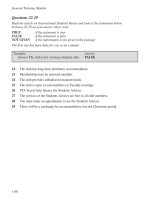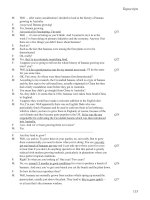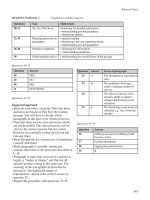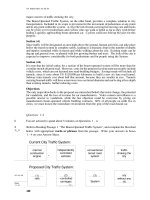Tài liệu Cambridge Practice Tests for IELTS part 3 pptx
Bạn đang xem bản rút gọn của tài liệu. Xem và tải ngay bản đầy đủ của tài liệu tại đây (647.64 KB, 15 trang )
Reading
occasionally had members that have been roundly censured in the national press.
These include Robin Hill Adventure Park on the Isle of Wight, which many
considered the most notorious collection of animals in the country. This
establishment, which for years was protected by the Isle’s local council (which
viewed it as a tourist amenity), was finally closed down following a damning
report by a veterinary inspector appointed under the terms of the Zoo Licensing
Act 1981. As it was always a collection of dubious repute, one is obliged to
reflect upon the standards that the Zoo Federation sets when granting
membership. The situation is even worse in developing countries where little
money is available for redevelopment and it is hard to see a way of incorporating
collections into the overall scheme of the WZCS.
Even assuming that the WZCS’s 1,000 core zoos are all of a high standard
complete with scientific staff and research facilities, trained and dedicated
keepers, accommodation that permits normal or natural behaviour, and a policy
of co-operating fully with one another what might be the potential for
conservation? Colin Tudge, author of Last Animals at the Zoo (Oxford University
Press, 1992), argues that “if the world”s zoos worked together in co-operative
breeding programmes, then even without further expansion they could save
around 2,000 species of endangered land vertebrates’. This seems an extremely
optimistic proposition from a man who must be aware of the failings and
weaknesses of the zoo industry the man who, when a member of the council of
London Zoo, had to persuade the zoo to devote more of its activities to
conservation. Moreover, where are the facts to support such optimism?
Today approximately 16 species might be said to have been “saved” by captive
breeding programmes, although a number of these can hardly be looked upon
as resounding successes. Beyond that, about a further 20 species are being
seriously considered for zoo conservation programmes. Given that the
international conference at London Zoo was held 30 years ago, this is pretty
slow progress, and a long way off Tudge’s target of 2,000.
26
Practice Test 1
Example Answer
London Zoos advertisements are poorly presented. NOT GIVEN
Questions 16-22
Do the following statements agree with the views of the writer in Reading Passage 2?
In boxes 16-22 write
YES if the statement agrees with the writer
NO if the statement contradicts the writer
NOT GIVEN if it is impossible to say what the writer thinks about this
16 London Zoo’s advertisements are dishonest.
17 Zoos made an insignificant contribution to conservation up until 30 years ago.
18 The WZCS document is not known in Eastern Europe.
19 Zoos in the WZCS select list were carefully inspected.
20 No-one knew how the animals were being treated at Robin Hill Adventure Park.
21 Colin Tudge was dissatisfied with the treatment of animals at London Zoo.
22 The number of successful zoo conservation programmes is unsatisfactory.
Questions 23-25
Choose the appropriate letters A-D and write them in boxes 23-25 on your answer sheet.
23 What were the objectives of the WZCS document?
A to improve the calibre of zoos world-wide
B to identify zoos suitable for conservation practice
C to provide funds for zoos in underdeveloped countries
D to list the endangered species of the world
24 Why does the writer refer to Robin Hill Adventure Park?
A to support the Isle of Wight local council
B to criticise the 1981 Zoo Licensing Act
C to illustrate a weakness in the WZCS document
D to exemplify the standards in AAZPA zoos
Reading
List of Factors
A the number of unregistered zoos in the world
B the lack of money in developing countries
C the actions of the Isle of Wight local council
D the failure of the WZCS to examine the standards of
the “core zoos”
E the unrealistic aim of the WZCS in view of the
number of species “saved” to date
F the policies of WZCS zoo managers
25 What word best describes the writer’s response to Colin Tudges’ prediction on captive
breeding programmes?
A disbelieving
B impartial
C prejudiced
D accepting
Questions 26-28
The writer mentions a number oj factors
H hich lead him to doubt the value of the WZCS
document Which THREE of the following factors are mentioned? Write your answers (A-F)
in boxes 26-28 on your answer sheet.
28
Practice Test 1
READING PASSAGE 3
You should spend about 20 minutes on Questions 29-40 which are based on Reading Passage
3 below.
ARCHITECTURE Reaching for the Sky
Architecture is the art and
science of designing buildings
and structures. A building
reflects the scientific and
technological achievements
of the age as well as the ideas
and aspirations of the
designer and client. The
appearance of individual
buildings, however, is often
controversial.
The use of an architectural
style cannot be said to start or
finish on a specific date.
Neither is it possible to say
exactly what characterises a
particular movement. But the
origins of what is now
generally known as modern
architecture can be traced
back to the social and
technological changes of the
18th and 19th centuries.
Instead of using timber,
stone and traditional building
techniques, architects began
to explore ways of creating
buildings by using the latest
technology and materials
such as steel, glass and
concrete strengthened steel
bars, known as reinforced
concrete. Technological
advances also helped bring
about the decline of rural
industries and an increase in
urban populations as people
moved to the towns to work in
the new factories. Such rapid
and uncontrolled growth
helped to turn parts of cities
into slums.
By the 1920s architects
throughout Europe were
reacting against the
conditions created by
industrialisation. A new style of
architecture emerged to reflect
more idealistic notions for the
future. It was made possible by
new materials and construction
techniques and was known as
Modernism.
By the 1930s many buildings
emerging from this movement
were designed in the
International Style. This was
largely characterised by the bold
use of new materials and simple,
geometric forms, often with
white walls supported by stilt
like pillars. These were stripped
of unnecessary decoration that
would detract from their primary
purpose — to be used or lived in.
Walter Gropius, Charles
Jeanneret (better known as Le
Corbusier) and Ludwig Mies van
der Rohe were among the most
influential of the many architects
who contributed to the
development of Modernism in
the first half of the century. But
the economic depression of the
1930s and the second world war
(193945) prevented their ideas
from being widely realised until
the economic conditions
improved and wartorn cities
had to be rebuilt. By the 1950s,
the International Style had
developed into a universal
approach to building, which
standardised the appearance of
new buildings in cities across the
world.
Unfortunately, this Modernist
interest in geometric simplicity
and function became exploited
for profit. The rediscovery of
quickandeasytohandle
reinforced concrete and an
improved ability to
prefabricate building sections
meant that builders could
meet the budgets of
commissioning authorities
and handle a renewed
demand for development
quickly and cheaply. But this
led to many badly designed
buildings, which discredited
the original aims of
Modernism.
Influenced by Le
Corbusier’s ideas on town
planning, every large British
city built multistorey housing
estates in the 1960s. Mass
produced, lowcost highrises
seemed to offer a solution to
the problem of housing a
growing innercity population.
But far from meeting human
needs, the new estates often
proved to be windswept
deserts lacking essential
social facilities and services.
Many of these buildings were
poorly designed and
constructed and have since
been demolished.
By the 1970s, a new respect
for the place of buildings
within the existing townscape
arose. Preserving historic
buildings or keeping only their
facades (or fronts) grew
common. Architects also
began to make more use of
building styles and materials
that were traditional to the
area. The architectural style
usually referred to as High
Tech was also emerging. It
Reading
celebrated scientific and
engineering achievements by
openly parading the
sophisticated techniques
used in construction. Such
buildings are commonly
made of metal and glass;
examples are Stansted
airport and the Lloyd’s
building in London.
Disillusionment at the
failure of many of the poor
imitations of Modernist
architecture led to interest in
various styles and ideas from
the past and present. By the
1980s the coexistence of
different styles of architecture in
the same building became
known as Post Modern. Other
architects looked back to the
classical tradition. The trend in
architecture now favours smaller
scale building design that
reflects a growing public
awareness of environmental
issues such as energy
efficiency. Like the Modernists,
people today recognise that a
well designed environment
improves the quality of life but is
not necessarily achieved by
adopting one well defined style
of architecture.
Twentieth century
architecture will mainly be
remembered for its tall
buildings. They have been
made possible by the
development of light steel
frames and safe passenger
lifts. They originated in the US
over a century ago to help
meet the demand for more
economical use of land. As
construction techniques
improved, the skyscraper
became a reality.
Ruth Coleman
Questions 29-35
Complete the table below using information from Reading Passage 3. Write NO MORE
THAN THREE WORDS for each answer. Write your answers in boxes 29-35 on your answer
sheet.
PERIOD
STYLE OF
PERIOD
BUILDING
MATERIALS
CHARACTERISTICS
Before 18th
century
Example
traditional
(29)
1920s
introduction of
(30)
steel, glass and
concrete
exploration of latest
technology
1930s -
1950s
(31) geometric forms
1960s
decline of
Modernism
pre-fabricated
sections
(32)
1970s
end of Modernist
era
traditional materials
(33)
of historic buildings
1970s
beginning of
(34) era
metal and glass
sophisticated techniques
paraded
1980s Post-Modernism (35)
30
Practice Test 1
Questions 36-40
Reading Passage 3 describes a number of cause and effect relationships. Match each Cause
(36-40) in List A, with its Effect (A-H) in List B.
Write your answers (A-H) in boxes 36 40 on your answer sheet.
NB There are more effects in List B than you will need, so you will not use all of them. You
may use any effect more than once if you wish.
36 A rapid movement of people from
rural areas to cities is triggered by
technological advance.
37 Buildings become simple and
functional.
38 An economic depression and the
second world war hit Europe.
39 Multi-storey housing estates are
built according to contemporary
ideas on town planning.
40 Less land must be used for
building.
List A CAUSES
A The quality of life is improved.
B Architecture reflects the age.
C A number of these have been
knocked down.
D Light steel frames and lifts are
developed.
E Historical buildings are preserved.
F All decoration is removed.
G Parts of cities become slums.
H Modernist ideas cannot be put
into practice until the second half
of the 20th century.
List B EFFECTS
Writing
WRITING
WRITING TASK 1
You should spend about 20 minutes on this task.
The charts below show the results of a survey of adult education. The first chart
shows the reasons why adults decide to study. The pie chart shows how people
think the costs of adult education should be shared.
Write a report for a university lecturer, describing the information shown below.
You should write at least 150 words.
Interest in subject
How the costs of each
course should be shared
To gain qualifications
Helpful for current job
To improve prospects
of promotion
Enjoy
learning/studying
To able to change
jobs
To meet people
Taxpayer
25%
Individual
40%
Employer
35%
32
Practice Test 1
WRITING TASK 2
You should spend about 40 minutes on this task.
Present a written argument or case to an educated reader with no specialist knowledge of the
following topic:
There are many different types of music in the world today. Why do we need
music? Is the traditional music of a country more important than the
International music that is heard everywhere nowadays?
You should write at least 250 words.
Use your own ideas, knowledge and experience and support your arguments with examples
and relevant evidence.
SPEAKING
CANDIDATE’S CUE CARD Task 1
UNIVERSITY CLUBS AND ASSOCIATIONS
You have just arrived at a new university. It is orientation week and you
want to know about the different clubs and associations you can join.
Your examiner is a Student Union representative.
Ask the examiner about: types of clubs
meeting times
benefits
costs
IINTERVIEWER’S NOTES
UNIVERSITY CLUBS AND ASSOCIATIONS
Prompts for interviewer
Overseas Students Club
• Meets once a week in Student
Centre, near Library All welcome
• Helps you to meet other students
• Financial contributions welcome
Chess Club
• Meets once a week in Library Not suitable for beginners
• Plays other universities Serious players only
• No subscription
Table Tennis Club
• Meets every day at lunch-time in
student area near canteen All welcome
• Arranges tournaments
• $5.00 subscription
Speaking
34
LISTENING
Practice Test 2
SECTION 1 Questions 1-10
Complete the notes. Use NO MORE THAN THREE WORDS for each answer.
KATE
Her first impressions of the
town
Type of accommodation
Her feelings about the
accommodation
Name of course
Difficulties experienced on the
course
Suggestions for improving the
course
Example Quiet
(1)
(2)
Environmental Studies
(4)
(5)
Her feelings about the other
students
(3)
LUKI
First type of accommodation
Problem with the first
accommodation
Name of course
Comments about the
course
Suggestions for improving the
course
(6)
(7)
(9)
Computer room busy
(10)
Second type of
accommodation
(8)
35
SECTION 2 Questions 11-20
Complete the notes below. Use NO MORE THAN THREE WORDS for each answer.
There are many kinds of bicycles available:
racing
touring
(11)
ordinary
They vary in price and (12) .
Prices range from $50.00 to (13) .
Single speed cycles are suitable for (14) .
Three speed cycles are suitable for (15) .
Five and ten speed cycles are suitable for longer distances, hills
and (16) .
Ten speed bikes are better because they are (17) in
price but (18) .
Buying a cycle is like (19) .
The size of the bicycle is determined by the size of
the (20) .
Listening
36
Practice Test 2
SECTION 3 Questions 21-32
Questions 21-24
Circle the correct answer.
21 At first Fiona thinks that Martin’s tutorial topic is
A inappropriate.
B dull.
C interesting.
D fascinating.
22 According to Martin, the banana
A has only recently been cultivated.
B is economical to grow.
C is good for your health.
D is his favourite food.
23 Fiona listens to Martin because she
A wants to know more about bananas.
B has nothing else to do today.
C is interested in the economy of Australia.
D wants to help Martin.
24 According to Martin, bananas were introduced into Australia from
A India.
B England.
C China.
D Africa.
37
Listening
Questions 25-30
Complete Martin’s notes Use NO MORE THAN THREE WORDS for each answer.
Commercially grown
banana plant
Each banana tree produces
(25)
of bananas.
On modern plantations in tropical
conditions a tree can bear fruit after
(26) .
Banana trees prefer to grow (27) and they require
rich soil and (28) . The fruit is often protected by
(29) .
Ripe bananas emit a gas which helps other (30) .
Questions 31 and 32
Circle the TWO correct boxes.
Consumption of Australian bananas
A Europe
B Asia
C New Zealand
D Australia
E Other
38
Practice Test 2
A balanced diet
A balanced diet will give you enough vitamins for normal daily living.
Vitamins in food can be lost through (36) .
Types of vitamins:
(a) Fat soluble vitamins are stored by the body.
(b) Water soluble vitamins not stored, so you need
a (37) .
Getting enough vitamins
Eat (38) of foods.
Buy plenty of vegetables and store them in
(39) .
SECTION 4 Questions 33-41
Questions 33-35
Circle the correct answer
According to the first speaker:
33 The focus of the lecture series is on
A organising work and study. C coping with homesickness.
B maintaining a healthy lifestyle. D settling in at university.
34 The lecture will be given by
A the president of the Union. C a sports celebrity.
B the campus doctor. D a health expert.
According to the second speaker:
35 This week’s lecture is on
A campus food. C sensible eating.
B dieting. D saving money.
Questions 36-39
Complete the notes. Write NO MORE THAN THREE WORDS for each answer.
39
Listening
Questions 40-41
Complete the diagram by writing NO MORE THAN THREE WORDS in the boxes provided.
Example
sugar, salt and butter
40
milk, lean meat, fish,
nuts, eggs
41
bread, vegetables and
fruit
Try to avoid









